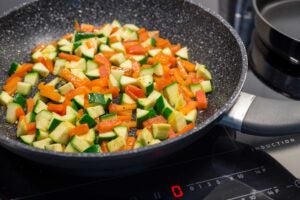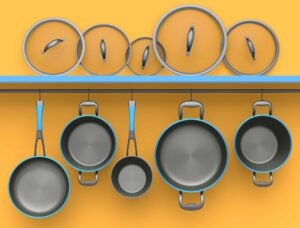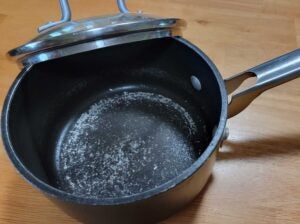I was recently in the market for a new set of nonstick cookware. My old set was a mishmash of random pieces that I held on to for a few years too long. I was overdue for a new set.
I had been seeing a lot of fearmongering regarding nonstick coatings recently, but mostly it was from brands selling an alternative. Obviously, I know enough not to take those claims at face value, but I also wanted to make sure what I ended up buying was going to be safe for myself and my family.
This is a topic that I’ve been getting a lot of questions about lately, so after doing a bit of research for my own purchasing purposes, I wanted to share with you what I learned and what I ended up purchasing.

There have been a lot of advancements and new materials brought to market since I last bought a decent nonstick skillet, and the choices can be a bit overwhelming.
First, I wanted to understand the difference between traditional nonstick cookware and ceramic nonstick cookware. I had seen so many beautiful Instagram photos of ceramic cookware that comes in an array of trendy colors. From a visual standpoint alone, I wanted to go with ceramic, but of course, there’s much more to consider regarding cookware than just looks.
One of the first things I learned about ceramic cookware is that the coating used doesn’t typically last as long as traditional nonstick cookware. The nonstick surface on ceramic cookware is made up of thin layers of silica. This coating tends to be more brittle than traditional nonstick surfaces, so it can scratch more easily and tends to break down faster.
However, it can be heated to higher temperatures than traditional nonstick surfaces, which are made up of polytetrafluoroethylene (PTFE). PTFE will break down and need to be replaced eventually as well, but this material is a bit tougher and can last a bit longer. I don’t typically have a need to heat my nonstick skillets above 500°F (260°C), so the fact that ceramic nonstick cookware can be heated up to 600°F unlike traditional nonstick cookware was not a selling point for me.

So, what about the safety of PTFE? This is where the marketing comes in for a lot of ceramic nonstick cookware brands that tout their coatings as a “non-toxic” alternative to PTFE, but is PTFE really toxic under normal cooking conditions?
This was one of my biggest questions when deciding between traditional and ceramic nonstick cookware. Again, I really liked the look of some of the ceramic sets I had seen, however, they were a bit more expensive than some of the hard anodized nonstick cookware sets I had been eyeing, and I wasn’t too keen on having to be more careful with handwashing and replacing more frequently, especially with the higher price tag of ceramic cookware.
Although traditional nonstick cookware used to be made with perfluorooctanoic acid (PFOA), this is no longer the case. The PFOA Stewardship Program, which aimed to reduce the health and environmental risks associated with PFOA exposure, led to the elimination of PFOA from nonstock cookware. Although PTFE cookware was not a significant source of PFOA due to the fact that most of it dissipated at high temperatures during the manufacturing process, nonstick cookware has been PFOA-free since 2013. PTFE is chemically inert and considered to be safe as long as it’s not heated to temperatures above 500°F as it can degrade and release dangerous fumes.
According to the American Cancer Society regarding non-stick cookware, “Other than the possible risk of flu-like symptoms from breathing in fumes from heated cookware with nonstick coatings, there are no proven risks to humans from using these products. While PFAS can be used in making some of these coatings, it is not present (or is present in extremely small amounts) in the final products.”
If you plan to heat your nonstick cookware over 500°F, then this would obviously not be the choice for you. Of course, even though ceramic nonstick cookware can be safely heated to higher temperatures (up to 600°F), it’s important that both traditional nonstick and ceramic nonstick cookware is not exposed to high heat or heated while empty.

Some other things you want to keep in mind, regardless of the nonstick surface, would be to avoid using metal utensils, which can scratch these surfaces, follow the manufacturer’s care instructions as some may recommend hand washing, and making sure to replace old cookware with excessive scratches, peeling, flaking, and chipping.
Taking all of this into consideration, my main criteria for choosing what I ultimately chose were the following: durability, cost, dishwasher safe, overall safety, and, of course, positive online reviews.
I ended up going with a set of Calphalon Classic Hard Anodized Nonstick cookware (this is not an ad). I’ve had this set for about eight months now and I’m very happy with my purchase. I may have chosen a ceramic set had I not looked further into the “toxic” claims regarding traditional nonstick cookware, which is why I wanted to pass this info on to you.
Of course, you may come to a different conclusion regarding what’s best for you, and that’s OK too.
Food Science Babe is the pseudonym of an agvocate and writer who focuses specifically on the science behind our food. She has a degree in chemical engineering and has worked in the food industry for more than decade, both in the conventional and in the natural/organic sectors.



